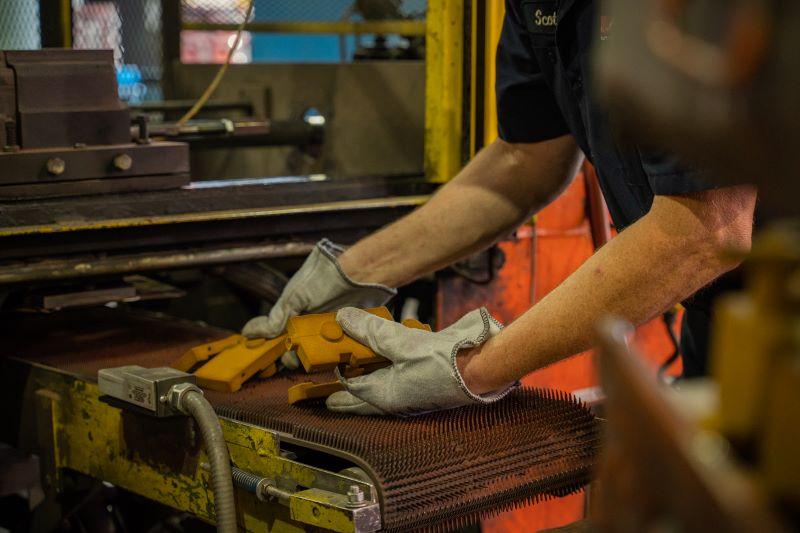Although humans have been casting metals for millennia, it is the emergence of the modern foundry that streamlined the process and set humanity on the path toward global industrialization. A foundry is a factory wherein metals are melted, poured into molds, and solidified into castings that may be usable on their own or as components in larger products or equipment.
The ductile iron foundry is a relatively new development in the grand scheme. The alloy was only discovered in 1943 (464 years after Moscow's "Canon Shop" and 301 years after colonial Massachusetts' Saugus Iron Works). Nonetheless, as the ductile iron casting process has evolved, so too has the ductile iron foundry — creating more durable, reliable, and consistent parts integral to a host of industries - while offering significant advantages over traditional cast iron parts.
How Urick excels at each step of the ductile iron casting process
It should come as no surprise that the best foundries are those that most smoothly facilitate each step of the ductile iron casting process. We'll take you through each one and explain how Urick does it better. Above all else, our team is committed to superior quality control throughout the entire ductile iron casting process.
Patternmaking
Before we cast anything, we must first know what we are casting. Once we have the engineering blueprints in hand, we can create a pattern for the green sand (moisture-containing) molds to follow. The patternmaker's primary responsibility is to fashion a production prototype that will minimize casting defects in the final product, compensating for shrinkage, machining, distortion, and draft. Consistency is both an art and a science, which is why Urick maintains lifetime patterns for our customers.
Molding
Once the pattern is ready, a metal frame called a flask is placed over top, creating a cavity for molding sand to be poured into. Greensand is packed around the upturned side of the pattern to create one-half of the mold, and the process is repeated for the other side. The two flasks are lined up for a complete mold.
Sand casting for parts with hollowed sections involves placing cores of hardened sand within the mold, sometimes supported by chaplets or spacers to prevent cave-ins. These temporary support structures then fuse into the molten metal when it is poured.
Fine-grain sand can make a tremendous difference in the surface finish and detail quality of ductile iron casting; that's why Urick Foundry uses the finest-grain sand in the industry.
Melting
The melting point of ductile iron is a staggering 2100°F (1149°C). To get it there, Urick enlists a powerful induction furnace, which utilizes alternating electrical currents to generate heat. "Charging" an active furnace with the metal to be melted is extremely dangerous, as even the slightest bit of moisture can instigate a violent steam explosion (water expands by a factor of 1,600 the instant it comes in contact with these temperatures)!
An often understated quality one might look for in a ductile iron foundry is highly skilled and trained workers. And we can't retain those employees unless we take every precaution to keep them safe! Urick's continuous commitment to improved working conditions garnered us the Emerson Safety Leadership Award from our parent company in 2020.
Pouring
Once the ductile iron reaches a molten state, it is tapped from a spout into an insulated pouring ladle. Slag and impurities are skimmed away before we make our way to the molding line. Molten metal flows from the ladle into a tapered pouring cup and funnels into a channel called the sprue.
The design of the mold dictates (as guided by the pattern) how the molten metal is directed. Runners allow the passage of molten metal between areas, while ingates are the entry points into the cavities that will form the casting. Risers fill with excess or reserve metal.
The Cooling Line
As discussed in our previous blog on heat treatments of ductile cast iron, the rates at which a casting is cooled can have a major influence on its physical and mechanical properties. During the cooling process, graphite molecules arrange themselves into spheroids rather than flakes, which is crucial for maintaining the desired microstructure.
Ejecting a casting too soon (while it's too hot) can adversely affect the balance of graphite microstructures we wish to maintain. Visually, a cooled ductile iron casting will appear gray.
In sand casting, mold removal is referred to as the "shakeout" and is usually performed by an agitation table, a vigorously vibrating apparatus that shakes and breaks the molding sand away and recaptures it in a box or conveyor underneath. Castings that contain cores may require additional steps and the core sand is recycled along with the molding sand.
Cleaning and Testing
Even if the previous steps have proceeded without a hitch, castings don't break out of their molds in pristine condition. You probably don't roll out of bed and leave the house immediately after waking up — likewise, ductile iron foundries put their castings through a beauty regimen in the cleaning room.
Cleaning involves mechanical and manual grinding, trimming, and sanding away excess metal to smooth rough edges. Surface imperfections will exist in the form of leftover sprue, gates, risers, and runners (the in-between, structural parts of the mold that facilitate flow). Raised "burrs" can also result from slight shifts of molten metal within the mold, as well as "flashing" — a skin-like layer of excess metal that is caused by miniature leaks where the mold meets ejector pins or the parting line.
Several tools can be employed in cleaning, including shot blasters, air-blast machines, tumbler drums, pneumatic hammers and drills (sand core removal), pressure washers and hydroblast systems, oxy-acetylene torches, chipping hammers, sleds, or saws.
Urick Foundry takes great care to carefully remove excess material to meet the dimensional requirements outlined in your engineering blueprints.
Inspection
Ductile iron foundries can use one of several methods to inspect the quality of their castings — visual (looking at it), magnetic particle (using magnetization to locate surface and shallow subsurface discontinuities), ultrasonic, and resonant frequency (aka Resonant Acoustic Method) testing.
Urick applies 100% resonant frequency testing to every part cast in our ductile iron foundry.
Power and finesse from Urick Ductile Iron Foundry
Urick has the resources and equipment for the biggest and toughest jobs, along with the expertise and dexterity to meet very exacting ASTM A536 standards. Our fine-grain sand will produce a surface finish, unlike most ductile iron castings you will see; its unique graphite structure provides excellent wear resistance, making it ideal for applications requiring the best in durability.
We are confident we are everything you're looking for in a ductile iron foundry!



